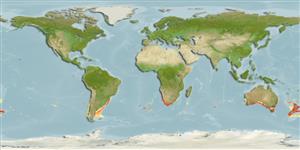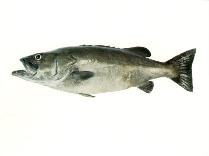Polyprion oxygeneios (Schneider & Forster, 1801)
Hapuku wreckfish
Beobachtung melden im Fish Watcher
| Native range | All suitable habitat | Point map | Year 2050 |

|
| This map was computer-generated and has not yet been reviewed. |
| Polyprion oxygeneios AquaMaps Data sources: GBIF OBIS |
Hochladen Photos und videos
Pictures | Stamps, coins, misc. | Google BildPolyprion oxygeneios
Picture by SeaFIC
Pictures | Stamps, coins, misc. | Google BildPolyprion oxygeneios
Picture by SeaFIC
New Zealand country information
Common names:
Groper, Haapuka, Hapuka
Occurrence: native
Salinity: marine
Abundance: | Ref:
Importance: commercial | Ref: Armitage, R.O., D.A. Payne, G.J. Lockley, H.M. Currie, R.L. Colban, B.G. Lamb and L.J. Paul (eds.), 1994
Aquaculture: | Ref:
Regulations: | Ref:
Uses: gamefish: yes;
Comments: Found around New Zealand, excluding Campbell Plateau (Ref. 9258). Most common over or near rocky areas, down to 250 m (Ref. 9258). Main fishing areas include the deep canyons off the east coast of the North Island, Cook Strait, off Kaikoura and off the west coat of the South Island (Ref. 9258). Landed throughout the year, but peaks in June to August (Ref. 9258). Recorded in the trawl survey in Chatham Islands (Ref. 45493) and off the east coast of South Island (Ref. 58461). Voucher specimen(s) held at the NMNZ. Also Ref. 7300, 9072, 9988, 45524, 52581, 75154.
National Checklist:
Country Information: https://www.cia.gov/library/publications/resources/the-world-factbook/geos/nz.html
National Fisheries Authority: http://www.fish.govt.nz/
Occurrences: Occurrences Point map
Main Ref: Paulin, C., A. Stewart, C. Roberts and P. McMillan, 1989
National Database:
Occurrence: native
Salinity: marine
Abundance: | Ref:
Importance: commercial | Ref: Armitage, R.O., D.A. Payne, G.J. Lockley, H.M. Currie, R.L. Colban, B.G. Lamb and L.J. Paul (eds.), 1994
Aquaculture: | Ref:
Regulations: | Ref:
Uses: gamefish: yes;
Comments: Found around New Zealand, excluding Campbell Plateau (Ref. 9258). Most common over or near rocky areas, down to 250 m (Ref. 9258). Main fishing areas include the deep canyons off the east coast of the North Island, Cook Strait, off Kaikoura and off the west coat of the South Island (Ref. 9258). Landed throughout the year, but peaks in June to August (Ref. 9258). Recorded in the trawl survey in Chatham Islands (Ref. 45493) and off the east coast of South Island (Ref. 58461). Voucher specimen(s) held at the NMNZ. Also Ref. 7300, 9072, 9988, 45524, 52581, 75154.
National Checklist:
Country Information: https://www.cia.gov/library/publications/resources/the-world-factbook/geos/nz.html
National Fisheries Authority: http://www.fish.govt.nz/
Occurrences: Occurrences Point map
Main Ref: Paulin, C., A. Stewart, C. Roberts and P. McMillan, 1989
National Database:
Common names from other countries
Klassifizierung / Names Namen | Synonyme | Catalog of Fishes(Gattung, Arten) | ITIS | CoL | WoRMS | Cloffa
> Acropomatiformes (Oceanic basses) > Polyprionidae (Wreckfishes)
Etymology: Polyprion: Greek, poly = a lot of + Greek, prion = saw (Ref. 45335).
More on authors: Schneider & Forster.
Etymology: Polyprion: Greek, poly = a lot of + Greek, prion = saw (Ref. 45335).
More on authors: Schneider & Forster.
Environment: milieu / climate zone / depth range / distribution range Ökologie
seewasser demersal; tiefenbereich 50 - 854 m (Ref. 52581). Subtropical; 28°S - 50°S, 180°W - 180°E
Verbreitung Länder | FAO Gebiete | Ecosystems | Vorkommen | Point map | Einführungen | Faunafri
Circumglobal in southern waters: (Ref. 7300): South Africa, Australia, New Zealand, Kermadec I., Desventuradas Is., Juan Fernandez Is., Chile, north to southern Brazil, Tristan da Cunha.
Length at first maturity / Size / Gewicht / Alter
Maturity: Lm 88.0 range ? - ? cm
Max length : 160 cm TL Männchen/unbestimmt; (Ref. 89467); common length : 100.0 cm TL Männchen/unbestimmt; (Ref. 9258); max. veröff. Gewicht: 100.0 kg (Ref. 4537); max. veröff. Alter: 60 Jahre (Ref. 41439)
Max length : 160 cm TL Männchen/unbestimmt; (Ref. 89467); common length : 100.0 cm TL Männchen/unbestimmt; (Ref. 9258); max. veröff. Gewicht: 100.0 kg (Ref. 4537); max. veröff. Alter: 60 Jahre (Ref. 41439)
Kurzbeschreibung Bestimmungsschlüssel | Morphologie | Morphometrie
Rückenflossenstacheln (insgesamt) : 9 - 12; Rückenflossenweichstrahlen (insgesamt) : 12; Afterflossenstacheln: 3; Afterflossenweichstrahlen: 7 - 9.
A deepwater species, occurs in seamounts (Ref. 89357). Adults occur generally over rough ground from the central shelf (about 100 m) to the shelf edge and down to the upper slope. Juveniles are found in surface waters, perhaps school in association with drifting weed. Feed on barracouta and pilchards, in addition to various bottom-dwelling fish. Are primary gonochorists (Ref. 58421). Preyed upon by sperm whales (Ref. 9072). It is taken by droplining down to 400 m, and is sometimes seen in the trawled catch. Utilized fresh and frozen; can be steamed, fried, broiled, boiled, microwaved and baked (Ref. 9988). Severely overfished (Ref. 89357).
Life cycle and mating behavior Geschlechtsreife | Fortpflanzung | Ablaichen | Eier | Fecundity | Larven
Are primary gonochorists (Ref. 58421).
Hauptreferenz
Upload your references | Referenzen | Koordinator : Sedberry, George | Partner
Paxton, J.R., D.F. Hoese, G.R. Allen and J.E. Hanley, 1989. Pisces. Petromyzontidae to Carangidae. Zoological Catalogue of Australia, Vol. 7. Australian Government Publishing Service, Canberra, 665 p. (Ref. 7300)
Bedrohung für Menschen
Harmless
Nutzung durch Menschen
Fischereien: kommerziell; Sportfisch: ja
FAO(Fischereien: production; publication : search) | FIRMS (Stock assessments) | FishSource | Sea Around Us
Mehr Information
Population dynamics
Growth parameters
Max. ages / sizes
Length-weight rel.
Length-length rel.
Längenhäufigkeiten
Mass conversion
Rekrutierung
Dichte
Growth parameters
Max. ages / sizes
Length-weight rel.
Length-length rel.
Längenhäufigkeiten
Mass conversion
Rekrutierung
Dichte
Life cycle
Fortpflanzung
Geschlechtsreife
Fecundity
Ablaichen
Spawning aggregations
Eier
Eientwicklung
Larven
Larven Pop.Dyn.
Fortpflanzung
Geschlechtsreife
Fecundity
Ablaichen
Spawning aggregations
Eier
Eientwicklung
Larven
Larven Pop.Dyn.
Anatomy
Kiemenoberfläche
Brain
Otolith
Kiemenoberfläche
Brain
Otolith
Physiology
Body composition
Nutrients
Oxygen consumption
Swimming type
Swimming speed
Visual pigments
Fish sound
Diseases & Parasites
Toxicity (LC50s)
Body composition
Nutrients
Oxygen consumption
Swimming type
Swimming speed
Visual pigments
Fish sound
Diseases & Parasites
Toxicity (LC50s)
Genetics
Genetik
Heterozygosity
Vererbbarkeit
Genetik
Heterozygosity
Vererbbarkeit
Human related
Aquaculture systems
Aquakultur Profile
Zuchtlinien
Ciguatera cases
Stamps, coins, misc.
Aquaculture systems
Aquakultur Profile
Zuchtlinien
Ciguatera cases
Stamps, coins, misc.
Tools
E-book | Feldführer | Längenhäufigkeits Tool | Lebensdaten Tool | Punkt Karte | Classification Tree
| Catch-MSY |
Zusatzinformationen
Download XML
Zusammenfassung | Point data | Namen | Photos
Internet Quellen
Aquatic Commons | BHL | Cloffa | BOLDSystems | Websites from users | FishWatcher Einträge suchen | CISTI | Catalog of Fishes(Gattung, Arten) | DiscoverLife | ECOTOX | Faunafri | Fishtrace | GenBank(Genom, nucleotide) | GloBI | GOBASE | | Google Books | Google Scholar | Google | IGFA World Record | MitoFish | Otolith Atlas of Taiwan Fishes | PubMed | Reef Life Survey | Scirus | SeaLifeBase | Tree of Life | Wikipedia(Gehe zu, Suchen) | World Records Freshwater Fishing | Zoological Record
Estimates based on models
Preferred temperature (Ref. 115969): 8.6 - 16, mean 11.7 (based on 143 cells).
Phylogenetic diversity index (Ref. 82804): PD50 = 0.8125 [Uniqueness, from 0.5 = low to 2.0 = high].
Bayesian length-weight: a=0.01072 (0.00765 - 0.01501), b=3.00 (2.90 - 3.10), in cm Total Length, based on LWR estimates for this species (Ref. 93245).
Trophic level (Ref. 69278): 4.5 ±0.77 se; based on food items.
Widerstandsfähigkeit (Ref. 120179): sehr niedrig, Verdopplung der Population dauert mehr als 14 Jahre. (tm=10-13; tmax=60).
Fishing Vulnerability (Ref. 59153): High vulnerability (59 of 100).
Climate Vulnerability (Ref. 125649): High to very high vulnerability (70 of 100).




